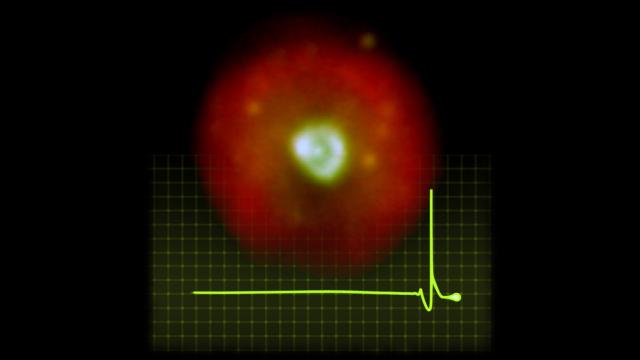When some stars get old they eject gas and dust, forming a cloud of electrically-charged material in space called a planetary nebula. These nebulae all tend to have the same layered structure, but a team of scientists recently spotted a kind of planetary nebula that looks to be inside out.
The nebula, called HuBi 1, is strange, but it doesn’t defy the laws of physics — it’s a case of a planetary nebula surrounding a dim star that seems to have awakened on its way to death, emitting a shock wave that caused the nebula to look inside-out. Studying these stars could help scientists understand the evolution of stars in general.
“Everyone thought it was impossible,” study author Martín Guerrero, from the Instituto de Astrofísica de Andalucía in Spain, told Gizmodo. “But at the end, we have learned that there is a lot of physics on stellar evolution… in studying these funny things.”
Planetary nebulae are a relatively short phase in the evolution of lighter stars, lasting maybe tens of thousands of years. Lighter stars include ones the same size as to eight times the mass of our Sun.
When these stars are on their way to becoming white dwarves, they eject gas or dust while continuing to emit ultraviolet radiation. The radiation ionises, or knocks the electrons off of, the atoms in the gas. Closest to the star are highly ionised atoms, with less-ionised atoms farther away and neutral atoms in the outermost part of the nebula.
Telescope observations of HuBi 1 seem to present the exact opposite case. Planetary nebulae are like onions with layers of gas. One would expect an inner layer of an ionised helium layer called [HeII], followed by twice-ionised oxygen called [OIII], then singly ionised oxygen [OII] and nitrogen [NII] mixed. Instead, they saw the reverse of that: [OII] surrounded by a shell of [NII] and [OIII], surrounded by an outer shell of [HeII].
“We see in this truly unique planetary nebula is what’s closer… has lower ionisation, and what’s farther has higher ionisation,” Guerrero said.
How does this happen? The scientists looked at older observations of the star at the nebula’s centre and found it appeared to have dimmed by 10,000 times in the past 46 years, according to the paper published in Nature Astronomy. This suggests that they were viewing the nebula in the midst of the gas encountering the rapid effects of the star’s dimming.
Such a strange reverse structure is typical of a shock wave travelling through ionised matter, the authors wrote. Perhaps the star woke up again and ejected another layer of matter outward through the gas — it was “born again”.
The [HeII] they expected at the inner parts of the nebula would now instead mark the location of the shock wave, while the reversed [OIII], [OII] and [NII] would mark the cooling after the shock wave passed. And, with the star obscured by a layer of dust from the ejected matter, it isn’t supplying the necessary energy to ionise those elements.
These are just interpretations of the data, so further observations could help better tell the story. But if their hunch is correct, then they can expect to see the nebula continue expanding from the shock wave, until they see the star again through the dispersing dust.
And finally, models suggest that the star weighed around 1.1 times the mass of our own Sun. Perhaps one day the Sun, too, will become a strange, born-again star cocooned in an inside-out nebula.
